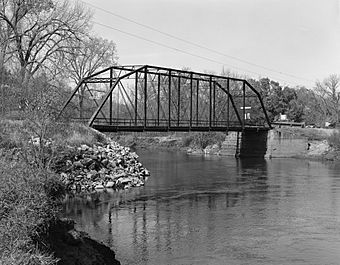Dodd Ford Bridge facts for kids
Quick facts for kids |
|
|
Dodd Ford Bridge
|
|

Dodd Ford Bridge in 1993
|
|
| Location | Co. Hwy. 147 over Blue Earth River, near Amboy, Minnesota |
|---|---|
| Built | 1901 |
| Architectural style | Pratt truss bridge |
| NRHP reference No. | 09001070 |
| Added to NRHP | December 9, 2009 |
The Dodd Ford Bridge is a historic bridge in Blue Earth County, Minnesota. It crosses the Blue Earth River near Amboy, Minnesota. This bridge was built in 1901. It is a special type of bridge called a steel Pratt truss bridge.
The Dodd Ford Bridge is important for a few reasons. It is one of the oldest overhead Pratt truss bridges still standing in Minnesota. It is also one of only two bridges known to have been built by Lawrence Henry Johnson. He was a very important bridge builder in Minnesota around the late 1800s and early 1900s.
Contents
Building the Dodd Ford Bridge
Before the bridge was built, people crossed the Blue Earth River at a shallow spot. This spot was called Dodd Ford. But crossing the river there was often hard for wagons and cars. So, in late 1900, the Blue Earth County leaders decided to build a bridge.
The local company Carlstrom Brothers built the two stone parts that hold up the bridge. These are called the piers. Many companies wanted to build the bridge. But the job went to Lawrence Henry Johnson. He offered the lowest price. Johnson finished building the bridge on time in June 1901.
Why the Bridge is Special
The Dodd Ford Bridge is one of the few bridges still around that Lawrence Henry Johnson built. It is a classic example of a Pratt truss bridge. This design was very common for highway bridges from about 90 to 150 feet long. The Dodd Ford Bridge is about 148.5 feet long.
The bridge was built with a narrow roadway, about 15 feet wide. It had a wooden deck. Later, the Minnesota Highway Commission said that new bridges needed to be wider. They also wanted steel parts and concrete decks. So, the Dodd Ford Bridge shows how bridges were built a long time ago.
The Bridge's Journey Through Time
For many years, the Dodd Ford Bridge stayed mostly the same. In the 1970s and 1980s, some small repairs were made. But in April 1993, the bridge was badly damaged. High water washed away part of its support. The county had to close the bridge and planned to replace it.
The bridge was closed to heavy vehicles for 30 years. Then, in May 2009, it was closed to all traffic. In December 2009, the bridge was added to the National Register of Historic Places. This means it is recognized as an important historic site. In 2010, a group called the Preservation Alliance of Minnesota listed it as one of the 10 most endangered historic places.
Good news! The Dodd Ford Bridge was repaired and reopened in the summer of 2016. Workers carefully lifted the metal part of the bridge off its old supports. They built strong new supports. Then, they placed the historic metal truss back on top. These new supports help the over 100-year-old bridge safely carry today's traffic. This way, its historic look is kept safe.
Images for kids
- Historic American Engineering Record (HAER) No. MN-73, "Dodd Ford Bridge, County Road 147 Spanning Blue Earth River, Amboy vicinity, Blue Earth County, MN"




